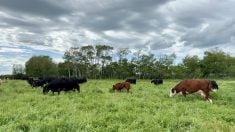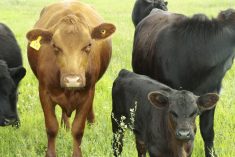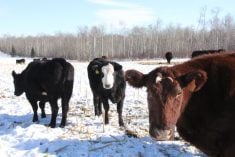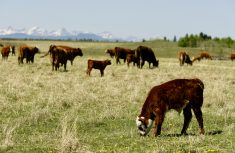This column is the last in a three-part series focusing on factors influencing the profitability of backgrounding cattle. To this point, we have covered economic and management issues related to this sector as well as the concept of formulating diets to match specific program objectives such as overwintering lightweight calves for grass and backgrounding medium- and larger-framed calves at moderate to higher rates of gain. To complete this discussion, I want to look at the opportunities and challenges one faces when using byproduct feeds in these programs.
Read Also

The Canadian Cattle Association’s international advocacy efforts
Global ag policies affect Canadian food policy, so the Canadian Cattle Association participates in international and domestic forums
I will start with the statement that I am a great believer in the use of byproduct feeds to background cattle. In my experience, byproduct feeds offer the opportunity to meet nutritional needs at a lower cost than programs based on many of our conventional feeds (i.e. cereal silage and/or grains). The key to byproduct use, however, is knowledge of their nutritional content and variability, their digestibility characteristics and the potential for mycotoxin contamination.
Many of the byproduct feeds available to the cattle industry arise out of the oilseed, grain and pulse processing sectors. Examples include oat hulls, pea starch concentrate, corn-dried distillers grains with solubles (DDGS) and canola meal. Others arise out of the grain trade such as grain screenings, pea/lentil screenings, corn cracks and thin oats. Finally, we have the more traditional byproducts from grain harvest such as cereal and flax straw and wheat chaff. Availability is usually restricted to regions where specific crops are grown or where processing activity is located.
RELATED: Don’t focus solely on price when using raw screenings as winter feed
Typically, I group byproduct feeds into three categories. These include sources of protein (CP), energy, and bulk or filler feeds. While there is often overlap in categorizing in this fashion, it does help to identify where they fit the best in the ration.
Protein sources include but are not restricted to wheat and corn DDGS, canola and soybean meal. These are relatively concentrated sources of protein ranging from 30 per cent CP in corn DDGS to 48 per cent or more in soybean meal. In addition, these byproducts tend to be relatively good sources of energy. For example, wheat DDGS is similar to barley grain while corn DDGS is closer to corn grain in terms of net energy (NE) content. Soybean meal is similar in NE content to corn DDGS while canola meal with its higher fibre content is the lowest energy source in this class. The principles of supply and demand often dictate pricing. Wheat DDGS, for example, is often purchased at or below cereal grain prices when there is an excess of product on the market, but if there is a shortage, prices can approach that of canola meal. Soybean meal typically is the highest-valued protein source of this class due to its superior protein and energy content.
Byproducts classified as energy sources can encompass a wide variety of products that differ dramatically in NE content. For example, pea starch concentrate or corn cracks have an NE content similar to or higher than that of the common cereal grains. Of the various screening products available across the country, pulse screenings tend to offer the best combination of energy and protein. Raw grain screenings tend to test better on feed analysis than their actual value in the ration. This is because their energy and protein contents are often associated with their weed seed content. When fed unprocessed, these weed seeds tend to go right through the animal undigested. In contrast, processed grain screenings, as well as byproducts such as thin oats and pea hulls, work well as intermediate sources of energy and protein in backgrounding rations.
RELATED: Oat miller to steer clear of lambda-cy
The final category is that of products used to bulk up the ration. In many cases with backgrounding rations, it is difficult to get the energy level of the diet low enough to achieve desired gains. In such cases, one needs to dilute the energy content of the ration with high-fibre, low-energy feeds. Oat hulls, a byproduct of the oat-processing sector, are ideal for this purpose. Other bulky low-energy feeds include cereal straw, flax straw and baled corn stover.
There are two major challenges when trying to develop backgrounding programs based on byproduct feeds. The first is variation in nutrient content between loads and the second is the potential for mycotoxin contamination. Screenings arising from the cleaning of cereals, particularly wheat and rye, can be significant sources of ergot, while aflatoxin can affect stored corn grain and any byproducts arising from it. To overcome these challenges, I would strongly recommend you develop a system for representative sampling and feed testing of incoming loads. As well, if you suspect grain screening or other byproduct shipments may be contaminated, analyze them for mycotoxins before feeding.
Finally, I end this column with a sense of nostalgia, as it is the last one I am writing for Canadian Cattlemen magazine under the Nutrition banner. I would like to thank the editors (past and current) for giving me a national platform to advance the concepts of beef cattle nutrition, a subject near and dear to my heart. I also want to thank you, the readers of this magazine, for sticking with me all these years and for asking the “offbeat” questions that so often ended up as topics for this column.

















